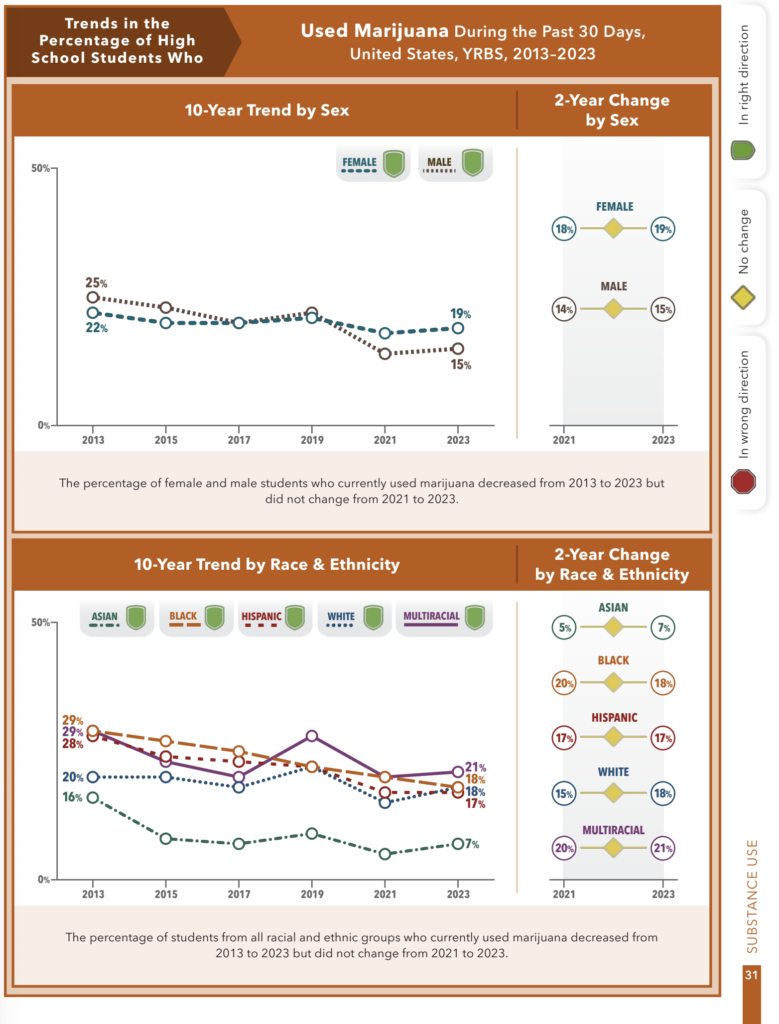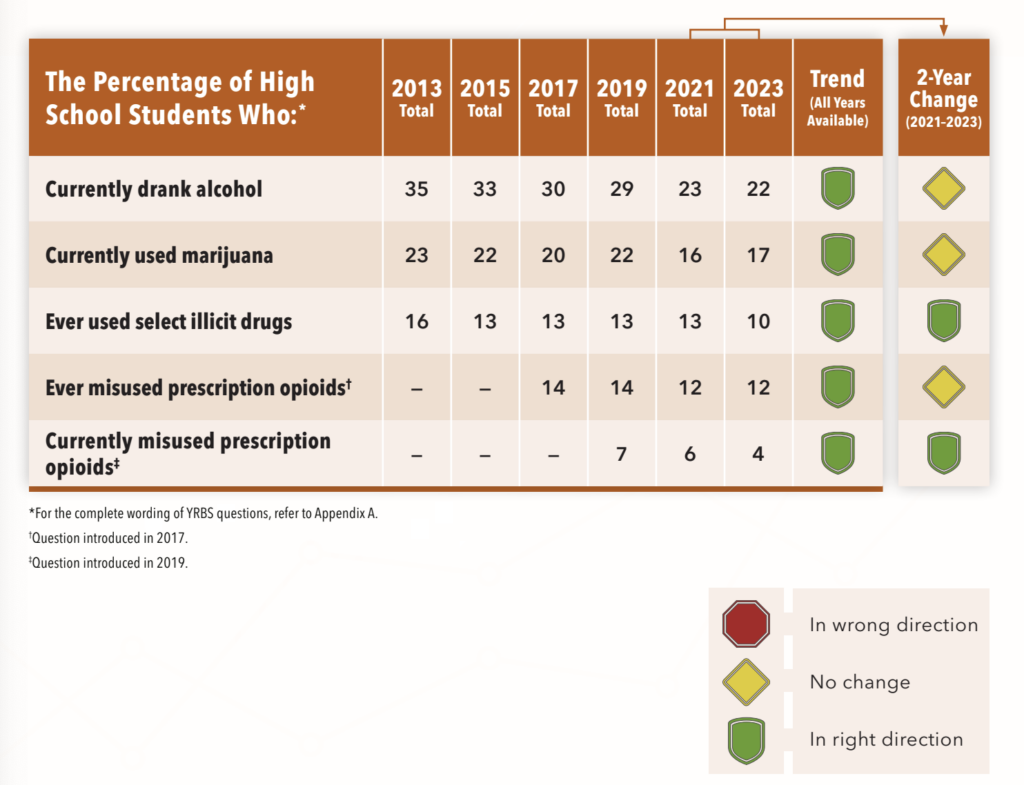Teen Marijuana Use Has Fallen Over The Past Decade As More States Enacted Legalization, New CDC Report Shows
FeaturedMarijuana IndustryMarijuana Industry News August 7, 2024 MJ Shareholders 0
Newly published results of a Centers for Disease Control and Prevention (CDC) survey show a decline in the proportion of high-school students reporting past-month marijuana use over the past decade, as dozens of states moved to legalize cannabis.
As of 2023, 17 percent of high-school students reported using marijuana within the past month, according to the newly released 2023 Youth Risk Behavior Survey. That’s down from 23 percent in 2013.
The federal survey is conducted every two years and focuses on substance use, sexual behavior, mental health, experiences of violence and suicidal thoughts and behaviors.
Though youth use rates have ticked up and down by a few percentage points from survey to survey within the 10-year timespan covered by the CDC report, the overall trend is that past-month use among high-school students has declined since 2013, the data show.
Notably, male students showed a more marked drop in marijuana use over the past decade, with rates falling from 25 percent in 2013 to 15 percent in 2023. Among female students over the same time period, rates decreased from 22 percent to 19 percent.
“There have been promising declines in high school students’ use of substances,” the report notes. “All substance use behaviors included in this report decreased during the years that trends were measured. Since 2013, the percentage of students who currently drank alcohol, currently used marijuana, or had ever used select illicit drugs decreased.”
The decline in teen cannabis use is contrary to the fears of legalization opponents who have continually warned that ending prohibition of marijuana for adults would trigger large increases in youth consumption.
Yet, past-month youth marijuana use rates fell across all surveyed racial groups during the past 10 years, the CDC data show.

CDC
Over the most recent two-year period—from 2021 to 2023—high-school marijuana use rates rose slightly, from 16 percent to 17 percent among all surveyed students, though CDC reported the difference as “no change” in the new report.
Past-month alcohol use among surveyed teens remained more popular than past-month cannabis use, meanwhile, though it also fell from 2013 to 2023, from 35 percent to 22 percent respectively.
Twelve percent of students in 2023 said they had ever misused prescription opioids. That proportion has fallen slightly since the question was introduced in 2017. Four percent said they currently misuse prescription opioids—a number that’s dropped from 7 percent since the question was added in 2019.
“These data show that we’ve made some progress in tackling these issues in recent years, which proves that they are not insurmountable,” CDC Division of Adolescent and School Health Director Kathleen Ethier said in a press release. “However, there’s still much work ahead.”

CDC
The CDC report notes that female and LGBTQ+ students were more likely than their peers to engage in “most substance use behaviors,” noting that nearly “1 in 4 female students currently drank alcohol and 1 in 5 currently used marijuana.”
Further, it says that LGBTQ+ students “were about twice as likely as cisgender and heterosexual students to have ever used select illicit drugs and prescription opioids.”
When it comes to cannabis, what’s especially notable is that high-school student use of marijuana was trending up from 2009 from 2013—before legal marijuana dispensaries started opening—according to CDC data published last year, but has been generally on the decline since then. The first state recreational legalization laws were approved by voters in 2012, with regulated retail sales beginning in 2014.
The findings of the latest CDC report reinforce similar findings that youth cannabis use rates have for the most part held steady or declined as more states have moved to legalize and regulate the drug.
A recent federal report published by the Substance Abuse and Mental Health Services Administration (SAMHSA), for example, found that consumption among minors—defined as people 12 to 20 years of age—fell slightly in the past year. Despite methodological changes that make comparisons over time difficult, it also suggests that youth use has fallen significantly in the past decade.
The survey found that the percentage of young people aged 12 to 17 who’ve ever tried marijuana dropped 18 percent from 2014, when the first legal recreational cannabis sales in the U.S. launched, to 2023. Past-year and past-month rates among young people also declined during that time period.
“Sensational claims that adult-use legalization laws are linked with greater marijuana use by teens are simply not backed by reliable data,” NORML’s deputy director, Paul Armentano, said of the SAMHSA report. “These government findings ought to reassure lawmakers that cannabis access can be legally regulated in a manner that is safe, effective, and that does not inadvertently impact young people’s habits.”
On the other side of the issue, Kevin Sabet, the president of the anti-marijuana advocacy group Smart Approaches to Marijuana, used the release of the report to reiterate his opposition to federal rescheduling of marijuana.
“These drugs aren’t safe and they aren’t medicine,” he said. “This latest round of data should make it even more apparent that marijuana doesn’t meet the criteria to be rescheduled by the federal government.”
A separate poll published recently found that that more Americans smoke marijuana on a daily basis than drink alcohol every day—and that alcohol drinkers are more likely to say they would benefit from limiting their use than cannabis consumers are.
U.S. adults who drink alcohol are nearly three times as likely to say they’d be better off reducing their intake of the drug compared to marijuana consumers who said they’d benefit from using their preferred substance less often, the survey found. Further, it found that while lifetime and monthly alcohol drinking among adults was far more common than cannabis use, daily marijuana consumption was slightly more popular than daily drinking.
An earlier report published in the Journal of Studies on Alcohol and Drugs that found that secondhand harm caused by marijuana use is far less prevalent than that of alcohol, with respondents reporting secondhand harm from drinking at nearly six times the rate they did for cannabis.
Data from a Gallup survey published last August also found that Americans consider marijuana to be less harmful than alcohol, cigarettes, vapes and other tobacco products.
Another study out of Canada, where marijuana is federally legal, found that legalization was “associated with a decline in beer sales,” suggesting a substitution effect.
Separate research published earlier this year found that the use of marijuana alone was not associated with higher risk of a car crash, while alcohol—whether used by itself or combined with marijuana—showed a clear correlation with increased odds of a collision.
As for legalization’s impact on youth use of marijuana, multiple studies have debunked the idea that the reform broadly increases youth use, with most finding that consumption trends are either stable or decrease after the reform is implemented. Use by heavy users may increase, however.
For example, a research letter published by the Journal of the American Medical Association (JAMA) in April said there’s no evidence that states’ adoption of laws to legalize and regulate marijuana for adults have led to an increase in youth use of cannabis.
Another JAMA-published study earlier that month that similarly found that neither legalization nor the opening of retail stores led to increases in youth cannabis use.
Data from a recent Washington State survey of adolescent and teenage students found overall declines in both lifetime and past-30-day marijuana use since legalizations, with striking drops in recent years that held steady through 2023. The results also indicate that perceived ease of access to cannabis among underage students has generally fallen since the state enacted legalization for adults in 2012.
Rates of youth marijuana use in Colorado, meanwhile, declined slightly in 2023—remaining significantly lower than before legalization. That’s according to results of the biannual Healthy Kids Colorado Survey released this month that found that past-30-day use of cannabis among high schoolers was at 12.8 percent in 2023, a dip from the 13.3 percent reported in 2021.
A separate study late last year also found that Canadian high-school students reported it was more difficult to access marijuana since the government legalized the drug nationwide in 2019. The prevalence of current cannabis use also fell during the study period, from 12.7 percent in 2018–19 to 7.5 percent in 2020–21, even as retail sales of marijuana expanded across the country.
In December, meanwhile, a U.S. health official said that teen marijuana use has not increased “even as state legalization has proliferated across the country.”
“There have been no substantial increases at all,” said Marsha Lopez, chief of the National Institute on Drug Abuse’s (NIDA) epidemiological research branch. “In fact, they have not reported an increase in perceived availability either, which is kind of interesting.”
Another earlier analysis from CDC found that rates of current and lifetime cannabis use among high school students have continued to drop amid the legalization movement.
A study of high school students in Massachusetts that was published last November found that youth in that state were no more likely to use marijuana after legalization, though more students perceived their parents as cannabis consumers after the policy change.
A separate NIDA-funded study published in the American Journal of Preventive Medicine in 2022 also found that state-level cannabis legalization was not associated with increased youth use. The study demonstrated that “youth who spent more of their adolescence under legalization were no more or less likely to have used cannabis at age 15 years than adolescents who spent little or no time under legalization.”
Yet another 2022 study from Michigan State University researchers, published in the journal PLOS One, found that “cannabis retail sales might be followed by the increased occurrence of cannabis onsets for older adults” in legal states, “but not for underage persons who cannot buy cannabis products in a retail outlet.”
The trends were observed despite adult use of marijuana and certain psychedelics reaching “historic highs” in 2022, according to separate data released last year.
Where Vice Presidential Candidate Tim Walz Stands On Marijuana
MJ Shareholders
MJShareholders.com is the largest dedicated financial network and leading corporate communications firm serving the legal cannabis industry. Our network aims to connect public marijuana companies with these focused cannabis audiences across the US and Canada that are critical for growth: Short and long term cannabis investors Active funding sources Mainstream media Business leaders Cannabis consumers












No comments so far.
Be first to leave comment below.